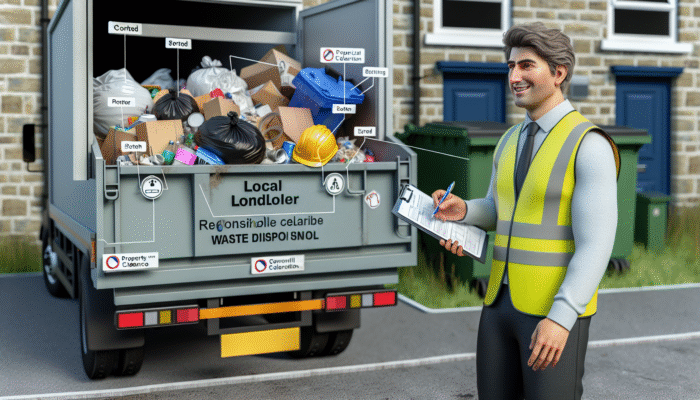Navigating UK Tenancy Laws for Legal Rental Clearance: A Complete Guide
Explore the Various Tenancy Agreements in the UK and Their Implications

Clearing a UK Rental Legally: Each rental arrangement within the UK is governed by specific legal frameworks that are essential for both landlords and tenants. The most prevalent form is the assured shorthold tenancy (AST), enabling landlords to regain possession of their property after an agreed-upon fixed term, typically lasting six to twelve months, contingent on appropriate notice being given. ASTs uniquely allow landlords to evict tenants without providing a stated reason once the fixed term concludes, provided sufficient notice is given. This flexibility is crucial for landlords who need to reclaim their properties swiftly and legally.
In addition to ASTs, other tenancy agreements such as assured tenancies offer tenants enhanced security and protection. These are mainly found in the social housing sector, where landlords must present a valid reason for eviction, thereby fortifying tenants’ rights. Recognizing these differences is vital for navigating the intricacies of legally clearing a UK rental. Landlords must ensure that they operate within the correct legal framework to prevent potential legal challenges during the property clearance process.
Furthermore, understanding the distinctions between periodic tenancies, which operate on a rolling monthly or weekly basis, and fixed-term agreements is crucial. A deep understanding of the nuances associated with each type of tenancy can significantly influence the strategy for property clearance and help identify possible legal hurdles. Adhering to the law ensures that the rights of all parties involved are safeguarded throughout the entire process.
Clarifying Tenant and Landlord Rights and Responsibilities in Rental Agreements
Both tenants and landlords possess specific rights and responsibilities outlined by UK law. For tenants, key rights include living in a safe environment, protection from retaliatory evictions, and the assurance of receiving their deposit back at the end of the tenancy, assuming no damages exceed normal wear and tear. Awareness of these rights is crucial to ensure that actions taken during the clearance process do not infringe upon them, thus safeguarding the tenant's interests.
On the other hand, landlords have obligations that include maintaining the property in a habitable state and ensuring that essential safety checks, like gas safety certificates, are up to date. They also retain the right to reclaim possession of the property in accordance with the laws governing tenancy agreements. This balance of rights and responsibilities is vital, especially as landlords prepare for property clearance; infringing on a tenant's rights can lead to significant legal disputes and claims.
Effective communication and meticulous documentation are critical in preserving these rights. Landlords should keep detailed records of interactions with tenants, service agreements, and property inspections. This transparency not only facilitates the legal clearance of a UK rental but also shields landlords from potential claims. Understanding these rights is fundamental for successful and compliant property management and clearance.
Mastering the Legal Requirements for Notice Periods and Eviction Processes
A thorough understanding of the required notice periods and eviction processes is essential for legally clearing a UK rental property. According to UK law, the necessary notice period can vary significantly based on the type of tenancy agreement in place. For assured shorthold tenancies, landlords typically need to provide a minimum of two months' notice if they intend to reclaim possession of their property. This notice period is crucial for ensuring that landlords comply with legal standards and avoid accusations of illegal eviction.
Moreover, the actual eviction process is governed by strict legal protocols. If a tenant does not vacate the premises following the notice period, landlords must apply for a possession order through the court system. This legal route is imperative; self-help evictions, such as changing locks or removing a tenant's belongings, are illegal and can result in severe legal implications. Familiarizing oneself with the judicial process, including the necessary paperwork and court appearances, is vital for landlords aiming to efficiently clear a rental property.
Additionally, landlords should be aware of the potential for tenant disputes. If a tenant perceives they have been wrongfully evicted, they may pursue legal action, which can considerably delay the clearance process. Therefore, maintaining comprehensive documentation and strictly adhering to the appropriate legal channels is crucial to ensure that the eviction process proceeds smoothly and within legal parameters.
Essential Steps for Effective Property Clearance Preparation

Creating Comprehensive Inventory and Condition Reports for Transparency
Before initiating the legal clearance process of a UK rental, it is imperative to develop detailed inventory and condition reports. An inventory serves as an exhaustive list that outlines the contents and condition of the property at the onset of a tenancy. This documentation proves invaluable for both landlords and tenants, as it establishes a clear record of what was present and its condition at the start of the tenancy. Such documentation is essential when assessing potential deposit deductions at the conclusion of the tenancy.
During the preparation for clearance, landlords should conduct a thorough inspection of the property, meticulously documenting any damages or wear and tear. This inspection process should encompass both photographs and written descriptions to create an irrefutable record. By keeping accurate inventory and condition reports, landlords not only safeguard their interests but also elevate the transparency of the clearance process.
Moreover, possessing an up-to-date inventory fosters clear expectations with incoming tenants. If the property is being prepped for new occupants, the condition report can reassure them of its status, thereby enhancing tenant satisfaction and building trust. The significance of this documentation extends beyond legal protections; it serves as a strategic asset for effective property management.
Carefully Managing Personal Belongings Left Behind by Tenants
Addressing personal belongings left behind by tenants can be one of the more intricate challenges during the legal clearance of a UK rental. When tenants vacate a property, they may leave behind furniture, clothing, or a variety of personal items, requiring landlords to handle this situation with diligence and consideration. The legal landscape surrounding abandoned property can differ; however, as a general rule, landlords should make reasonable efforts to reach out to the tenant regarding these items before proceeding with any actions.
Upon establishing contact, landlords are required to securely store these belongings for a designated period, typically around 14 days, allowing the previous tenant the chance to reclaim their possessions. After this period, if items remain unclaimed, landlords may possess the legal right to dispose of them. However, it is essential to document all communications and actions related to these belongings to mitigate any potential claims of wrongful disposal.
Additionally, landlords should contemplate enlisting professional clearance services for managing larger items. This approach guarantees compliance with disposal regulations and minimizes the likelihood of legal complications arising from improper handling of personal property. By adhering to these guidelines, landlords can adeptly navigate the complexities of clearing personal belongings while remaining compliant with UK law.
Ensuring Responsible Rubbish and Waste Removal During Clearance

Removing rubbish and waste is a vital aspect of legally clearing a UK rental, accompanied by its own set of legal responsibilities. Landlords must adhere to local waste disposal regulations, which can differ significantly across various councils in the UK. Comprehensive research into the specific requirements for waste disposal in the property's locality is essential to ensure compliance.
In many cases, landlords are prohibited from discarding waste in public areas or general refuse bins. Instead, they may need to arrange for bulky waste collections or dispose of items at designated disposal sites. Collaborating with local councils or waste management companies can provide landlords with the necessary guidance to fulfill their legal obligations while ensuring a clean and compliant property clearance process.
Moreover, it is crucial to be aware of hazardous waste regulations. Items such as old appliances, chemicals, or construction materials necessitate specialized handling and disposal methods. Non-compliance with these regulations can lead to hefty fines and legal repercussions. Therefore, understanding the local laws regarding waste disposal is vital for efficiently and legally clearing a UK rental.
Collaborating with Professional Clearance Services for Enhanced Efficiency
Engaging professional services can significantly streamline the property clearance process, ensuring both compliance and efficiency. It is crucial for landlords to partner with a clearance service that operates legally within the UK to clear their properties without infringing upon the law.
Landlords should commence their search by researching reputable clearance companies and verifying their credentials and customer feedback. It is critical to ensure that these companies are licensed and insured, as collaborating with unqualified services can lead to complications and potential legal issues. A well-reviewed clearance service will not only expedite the process but also possess the expertise to safely handle various types of items while adhering to local regulations.
Once a suitable company has been identified, clear communication becomes essential. Landlords should discuss their expectations, timelines, and any specific requirements related to the clearance process. A professionally managed clearance can alleviate stress for landlords and provide peace of mind that the property will be managed appropriately. Furthermore, this collaboration can enhance the overall efficiency of the clearance process, allowing landlords to concentrate on securing new tenants or preparing the property for sale.
Maximizing the Advantages of Professional Clearance Services
Finding a Reliable Clearance Company Tailored to Your Needs
Choosing a trustworthy professional clearance service is a crucial step in the legal clearance of a UK rental property. Landlords should look for companies that have built a solid reputation within the industry. Online reviews, testimonials, and personal recommendations can serve as invaluable resources in identifying reliable services.
Moreover, it is essential to verify that the clearance company is licensed to operate in the UK. This licensing typically ensures that the company complies with local regulations regarding waste disposal and property clearance. Engaging a licensed service reduces the likelihood of encountering legal issues and ensures that the company is well-acquainted with the specific protocols needed for effective property clearance.
Additionally, when selecting a clearance service, landlords should inquire about the types of items the company is equipped to handle. A reputable company will be adept at safely removing a wide range of items, from general waste to hazardous materials, ensuring compliance with health and safety regulations.
Another factor to consider is the level of customer service provided by the clearance company. A company that prioritizes its clients will be open to discussing their procedures, addressing inquiries professionally, and offering clear, transparent pricing structures. This commitment to customer service can significantly enhance the efficiency of the clearance process and ensure landlords feel supported throughout.
Thoroughly Reviewing Service Agreements for Clarity and Legal Protection
It is vital for landlords to meticulously review service agreements before finalizing arrangements with a clearance service. These documents outline the terms and conditions of the services to be provided, making it essential to fully comprehend these elements to prevent disputes later on.
Key aspects to scrutinize in a service agreement include the scope of work, timelines, and associated costs. The scope of work should clearly define what services will be performed, such as the removal of specific items or cleaning the property. Clarity in these details prevents misunderstandings and ensures that both parties share aligned expectations.
Timelines should also be explicitly stated, as delays can hinder the clearance process and disrupt landlords' plans. Furthermore, landlords should be cautious of any hidden fees that may surface during the clearance, ensuring that all costs are transparent and agreed upon. The importance of having a detailed and comprehensible service agreement cannot be overstated; it acts as a critical protective measure for both parties involved.
Additionally, including cancellation policies and liability clauses in these agreements is valuable. Understanding these provisions can help landlords navigate unexpected situations and ensure that they are protected should issues arise during the clearance process. Taking the time to comprehend service agreements is essential for ensuring a smooth and legally compliant property clearance.
Analyzing Costs and Obtaining Estimates for Effective Budgeting
Cost considerations play a pivotal role in the decision-making process when hiring professional clearance services. Landlords should obtain estimates from multiple companies to ensure competitive pricing. A reputable clearance service will typically provide a free, no-obligation quote after assessing the property and understanding the required scope of work.
When evaluating costs, landlords should consider the comprehensive nature of the services rendered. The cheapest option may not always represent the best value; therefore, it is important to weigh cost against quality. Services that offer additional features, such as thorough cleaning or diligent waste sorting, may justify higher costs due to their added convenience and efficiency.
Moreover, landlords should inquire about payment terms and whether any upfront fees are required. Understanding the financial implications of hiring a clearance service is crucial, as unexpected costs can strain a landlord's budget during what should ideally be a smooth transition.
Landlords should also remain vigilant regarding any hidden fees that may arise during the clearance process. A transparent service will outline all potential costs upfront, thus alleviating any unwelcome surprises. By carefully assessing costs and obtaining estimates, landlords can make informed decisions that align with their financial objectives while ensuring a legally compliant clearance.
Essential Legal Documentation and Compliance Considerations for Property Clearance
Crucial Legal Documents Needed for Property Clearance
When clearing a UK rental property, several vital legal documents are essential to ensure compliance with local laws and protect landlords' interests. Among the most important documents is the tenancy agreement, which defines the terms of occupancy and the specific responsibilities of both landlords and tenants. This document serves as a primary reference point when resolving any disputes that may arise during the clearance process.
Additionally, landlords should ensure they possess the appropriate eviction notices, such as Section 21 or Section 8, depending on the circumstances surrounding the tenancy. These notices must be served in accordance with legal requirements, and having copies readily accessible can facilitate a smoother clearance process.
It is also advisable to maintain records of all communications with tenants, including any correspondence regarding the property and notices served. This documentation will serve as crucial evidence should any disputes arise during or after the clearance process. Furthermore, if personal belongings are left behind, keeping records of efforts made to contact former tenants about reclaiming their possessions can also be advantageous.
Landlords should also be aware of any additional documentation required by local councils, especially concerning waste disposal laws. By organizing all necessary legal documents before initiating the clearance process, landlords can significantly mitigate the risk of legal complications and enhance the overall efficiency of property management.
The Importance of Record Keeping and Legal Compliance in Property Management
Maintaining accurate records throughout the property clearance process is paramount for ensuring compliance with UK legal standards. Landlords should implement a systematic approach to record keeping that encompasses all relevant documentation, such as tenancy agreements, eviction notices, inventories, and correspondence with tenants.
This meticulous record-keeping serves as a protective measure and promotes transparency throughout the clearance process. Should any disputes arise, having comprehensive records can provide landlords with the evidence necessary to defend their actions and decisions. This is particularly relevant in claims concerning deposit deductions or disputes over personal belongings left in the property.
Moreover, compliance with data protection regulations is essential when managing tenant information. Landlords must ensure they handle personal data responsibly, storing it securely and disposing of it appropriately once it is no longer required. This diligence not only protects tenants' rights but also shields landlords from potential legal repercussions associated with data breaches.
To enhance compliance, landlords should consider conducting regular audits of their records and ensuring all documentation is current. By remaining organized and maintaining accurate records, landlords can navigate the complexities of legally clearing a UK rental with confidence and peace of mind.
Proactively Managing Disputes and Claims During the Clearance Process
Disputes and claims frequently arise during the property clearance process, making it essential for landlords to understand the procedures for resolution. A common area of contention is the return of the tenant’s deposit. Landlords are legally obligated to return the deposit within a specified timeframe after the tenancy ends, provided there are no legitimate claims for damages or outstanding rent.
When disputes occur regarding deposit deductions, landlords should refer to their inventory reports and condition documentation to substantiate their claims. This evidence is crucial in demonstrating that any deductions are reasonable and legally defensible. If a tenant disputes the deductions, the matter may need to be resolved through a tenancy deposit scheme, which provides a neutral third party to evaluate the situation.
Additionally, landlords should be prepared for potential claims regarding personal belongings left behind. If tenants believe their possessions have been mishandled or improperly disposed of, they may seek legal recourse. Documenting all communications and actions taken regarding abandoned property can assist landlords in defending against such claims.
Engaging with a legal professional specializing in property law can provide landlords with invaluable support in navigating disputes. By understanding the resolution process and taking proactive measures to document all relevant information, landlords can effectively manage conflicts and ensure a seamless clearance process.
Adhering to Environmental and Safety Regulations During the Clearance Process
Identifying and Responsibly Managing Hazardous Materials
When clearing a UK rental property, being aware of environmental and safety regulations is of utmost importance, particularly concerning hazardous materials. One of the most significant concerns is asbestos, which can be present in many older buildings. Landlords are legally obligated to identify and manage any asbestos-containing materials within their properties, especially if renovation or clearance activities are planned.
Landlords must conduct a thorough risk assessment to determine the presence of asbestos before commencing any clearance work. If asbestos is found, it is essential to engage with a licensed asbestos removal contractor. These professionals are trained to handle hazardous materials safely and comply with regulations, thereby minimizing the risk of exposure for workers and the surrounding community.
Furthermore, landlords should also be aware of other hazardous materials, such as lead paint or mould. Proper management of these materials is not only a legal requirement but also vital for safeguarding the safety and well-being of future tenants. Failing to address hazardous materials appropriately can lead to significant legal repercussions and damage a landlord’s reputation.
Regular training and education on environmental regulations can assist landlords in staying informed about best practices for handling hazardous materials. By prioritizing safety and compliance, landlords can ensure that the property is cleared responsibly and in accordance with the law.
Understanding Waste Disposal Regulations for Legal Compliance
Grasping waste disposal regulations is critical for legally clearing a UK rental. Landlords must be informed about their local council's waste management policies, which can vary significantly from one region to another. A thorough understanding of these regulations is essential for ensuring that waste is disposed of properly, thus minimizing the risk of fines or legal complications.
Landlords should allocate time to research the appropriate procedures for disposing of various types of waste, including bulky items, hazardous materials, and general refuse. Many local councils offer specific guidance on managing waste and may provide services for collecting unwanted items. Utilizing these services ensures compliance while contributing to responsible environmental practices.
Additionally, landlords must be mindful of landfill regulations governing the disposal of specific materials. Numerous councils impose strict policies regarding what can and cannot be dumped in landfills, and failing to adhere to these regulations can lead to substantial penalties. Understanding these guidelines is crucial for landlords seeking to clear their properties legally and ethically.
By aligning their clearance practices with local waste disposal regulations, landlords can promote environmental sustainability while protecting themselves from potential legal ramifications. This proactive approach enhances the efficiency of the property clearance process, ensuring that it is conducted responsibly and competently.
Ensuring Compliance with Health and Safety Regulations During Clearance
Ensuring adherence to health and safety regulations during the clearance process is not merely a legal obligation but also a moral responsibility for landlords. The Health and Safety at Work Act 1974 provides a framework for maintaining safe working conditions, extending to any activities conducted during the clearance of a rental property.
Landlords should perform comprehensive risk assessments to identify potential hazards associated with the clearance process, such as heavy lifting, exposure to hazardous materials, or unsafe working environments. These assessments will guide landlords in implementing necessary safety measures to protect both themselves and any contractors involved.
Furthermore, providing workers with suitable personal protective equipment (PPE) during the clearance is essential for compliance. Depending on the nature of the work, this may include hard hats, gloves, masks, or safety goggles. By prioritizing health and safety compliance, landlords can foster a secure working environment that reduces the likelihood of accidents or injuries.
Regular training sessions and updates on health and safety regulations can further enhance a landlord's preparedness for property clearance activities. Staying informed about legislative changes and best practices ensures that landlords operate within legal boundaries while promoting a culture of safety and responsibility throughout the clearance process.
Effectively Finalizing the Property Clearance Process
Conducting Thorough Inspections and Final Walkthroughs for Compliance
Carrying out comprehensive inspections and final walkthroughs is a crucial phase in legally clearing a UK rental. This stage follows the completion of the clearance and serves the dual purpose of verifying that the property is in an acceptable condition and confirming that all items have been correctly removed.
Landlords should implement a checklist-based inspection covering all areas of the property, including interiors, exteriors, and any outbuildings. This detailed approach ensures that no details are overlooked and that the property meets the required standards for cleanliness and safety. Photographs taken during this inspection can provide valuable documentation, especially if disputes arise regarding the property's condition after clearance.
Moreover, involving a third party, such as a property management professional, during the final walkthrough can offer an unbiased assessment of the property's condition. This can be particularly beneficial in identifying areas requiring further attention or repair before new tenants move in.
Final inspections also present an opportunity to verify that all legal obligations have been satisfied, such as proper waste disposal and adherence to health and safety regulations. By conducting thorough inspections and walkthroughs, landlords can ensure that the property is well-prepared for its next occupants, thereby enhancing tenant satisfaction and reducing the likelihood of future disputes.
Facilitating a Seamless Handover to New Tenants or Owners
After the clearance process is complete, the next priority for landlords is ensuring a smooth handover of the property to new tenants or owners. This stage is critical in establishing a positive relationship with incoming tenants while ensuring compliance with all legal obligations.
Before handing over the keys, landlords should provide new tenants with all pertinent information about the property, including appliance instructions, emergency contacts, and details about local services. This transparency fosters trust and helps new tenants feel welcomed in their new home.
Additionally, landlords should conduct a final walkthrough with the new tenants, allowing them to inspect the property and address any questions or concerns they may have. This proactive approach not only sets a positive tone for the tenancy but also serves as a safeguard for landlords, as it documents the property's condition at the time of handover.
Finally, landlords should ensure that all legal documentation, such as tenancy agreements and inventories, is signed and exchanged during the handover process. This formalization protects both parties and clearly outlines their rights and responsibilities, creating a solid foundation for a successful tenancy.
Recognizing the Importance of Post-Clearance Follow-Up
Following up after the clearance process is essential to fulfilling all legal and contractual obligations. This follow-up allows landlords to identify any outstanding issues, such as repairs or compliance matters, that need to be addressed before new tenants move in.
Landlords should reach out to new tenants shortly after the handover to confirm their satisfaction with the property and to address any concerns that may have arisen. This proactive communication demonstrates a commitment to tenant welfare and can significantly enhance tenant retention.
Moreover, landlords should evaluate the overall clearance process. This assessment can include reviewing the services utilized, the effectiveness of communication with tenants, and adherence to legal requirements. Understanding the successes and challenges faced during the clearance can inform future practices, enabling landlords to improve their processes and avoid potential pitfalls.
By following up after the clearance, landlords can ensure that they are not only compliant with legal obligations but also cultivate positive relationships with their tenants. This dedication to excellence paves the way for a successful rental experience and fosters long-term success in property management.
Commitment to Ongoing Documentation and Record Keeping for Future Reference
Maintaining accurate records and documentation throughout the clearance process is crucial for compliance and future reference. Landlords should compile all relevant paperwork into a comprehensive file, including inventories, inspection reports, and communication with tenants. This documentation becomes a valuable resource for future tenancies and can prove indispensable in disputes.
Furthermore, landlords must adhere to data protection regulations when managing tenant information. Ensuring that all personal data is stored securely and disposed of appropriately is essential for protecting tenant privacy and complying with legal standards.
Landlords should also consider implementing a systematic approach to record-keeping, including digital storage solutions that enable easy access and retrieval of documents. By adopting an organized system, landlords can minimize the risk of lost documents and enhance their overall efficiency in property management.
In addition to compliance, thorough documentation can provide landlords with insights into their properties over time. Tracking repairs, tenant feedback, and property conditions can guide future improvements and decision-making. By prioritizing documentation and record-keeping, landlords can navigate the complexities of legally clearing a UK rental while promoting a culture of transparency and responsibility.
Frequently Asked Questions About UK Tenancy Laws
What Are the Main Types of Tenancy Agreements in the UK?
The primary types of UK tenancy agreements include assured shorthold, assured, and periodic tenancies. Each type assigns specific rights and responsibilities to both landlords and tenants.
How Much Notice Must I Give Tenants Before Eviction?
For assured shorthold tenancies, landlords are required to provide at least two months' notice for eviction. This notice must be served in accordance with legal requirements to ensure its validity.
What Should I Do with Personal Belongings Left Behind by Tenants?
Landlords must make reasonable efforts to contact former tenants regarding their belongings. If items remain unclaimed after a specified period, they may be disposed of legally following local regulations.
Are There Legal Requirements for Waste Disposal During Clearance?
Yes, landlords are mandated to adhere to local waste disposal regulations, which often prohibit illegal dumping and dictate proper disposal methods for various types of waste.
How Can I Select a Reputable Clearance Service?
Research online reviews, verify credentials, and seek licensed and insured companies. Transparency in pricing and services offered is also essential for informed decision-making.
What Documents Are Necessary for Clearing a Rental Property?
Essential documents include tenancy agreements, eviction notices, inventory reports, and records of tenant communications.
How Can I Ensure Compliance with Health and Safety Regulations?
Conduct risk assessments, provide appropriate PPE, and remain updated on current health and safety laws relevant to property management and clearance activities.
What Steps Should I Take for Handover to New Tenants?
Provide new tenants with comprehensive property information, conduct a final walkthrough, and ensure all legal documentation is signed and exchanged during the handover process.
How Can I Effectively Manage Disputes During the Clearance Process?
Maintain thorough records, communicate openly with tenants, and consider consulting legal professionals if disputes arise regarding deposits or property conditions.
Why Is Post-Clearance Follow-Up Important?
Conducting follow-ups ensures tenant satisfaction, addresses potential issues early, and helps landlords evaluate the clearance process for future improvements.
Connect with us on Facebook!
The Article: Clearing a UK Rental Legally: A Comprehensive Guide Was First Found At https://birminghamhouseclearance.com
The Article UK Rental Clearance: A Complete Legal Guide Was Found On https://limitsofstrategy.com

